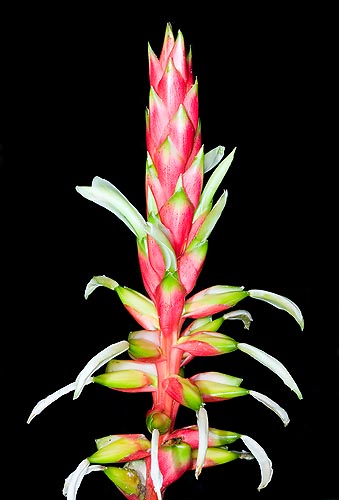Family : Bromeliaceae

Text © Pietro Puccio

English translation by Mario Beltramini

Little tilled plant out from the Botanical gardens © Mazza
The Pitcairnia maidifolia (C.Morren) Decne. ex Planch. (1854) is native to the humid forests of Colombia, Costa Rica, Ecuador, Guyana, Honduras, Nicaragua, Panama, Surinam and Venezuela, between 100 and 2.500 m of altitude.
The genus is honoured to the English physician Williams Pitcairn (1711-1791), passionate of botany and collector of exotic plants, in whose greenhouses was described the species typus; the name of the species comes from the Latinized English word “maize” = maize, Indian corn, and “folia” = leaf, with obvious signification.
Terrestrial, evergreen, herbaceous plant, monocarpic (bearing fruit only one time during its existence), it is provided with a strong stem and unarmed dimorphic leaves, the external ones are lanceolate, about 10 cm long, brown; the inner ones, on a 5-10 cm long peduncle, are lanceolate-acuminate, 50-100 cm long and 6-10 cm broad, of green colour. The inflorescence, at the centre of the rosette, is formed by a floral scape, long up to about 1 m, covered by a thin white tomentum and with enveloping bracts, longer than the internodes in the median part, shorter at the extremity, of a green colour, often shaded of red at the base. The scape ends with a 10-45 cm long racemose inflorescence with ovate, sharp, floral bracts, long about 3 cm, reddish except the apical part, which is green. The flowers, on a short peduncle, have elliptic, about 3 cm long, sepals, green or yellow shaded of red at the base, and linear, sharp, about 5 cm long, petals, of white or greenish white colour. The fruite is a capsule containing several pale yellow seeds.
It reproduces, besides by seed, by vegetative way through the new plants which come out at the base of the plant and which can be detached when they reach a size of at least one third of the mother plant. Not much known plant outside the Botanical Gardens and collectors, it can be cultivated in open air in the tropical and subtropical zones characterized by high and constant ambient humidity, in a position from slightly shaded to shaded, on very aerated, porous, draining and rich of organic substance substrata.
Elsewhere, it is to be cultivated in pot on substrata holding the same characteristics required for the outdoor cultivation, with temperatures over the 16°C, best 20-22°C, watering frequently in summer, less in winter, in order to allow the substratum to dry up in surface between the watering. The local humidity, in presence of dry air and high temperatures, can be increased with nebulisations utilizing water at room temperature and not calcareous, so to avoid anti-aestethic dots on the leaves. The plant tends to form tufts quickly, it is therefore suggested to utilize rather big pots, also for a better stability, seen its dimensions.
Synonyms: Puya maidifolia C.Morren (1849); Pitcairnia funckiana A.Dietr. (1851); Pitcairnia macrocalyx Hook. (1853); Pitcairnia zeifolia K.Koch (1855); Phlomostachys funckiana (A.Dietr.) Beer (1856); Neumannia maidifolia (C.Morren) K.Koch (1856); Lamproconus maidifolia (C.Morren) Jacob-Makoy (1879); Hepetis maidifolia (C.Morren) Mez (1896); Hepetis funckiana (A.Dietr.) Mez (1896); Hepetis oerstediana Mez (1896); Pitcairnia oerstediana (Mez) Mez (1935).
→ For general notions about BROMELIACEAE please click here.
